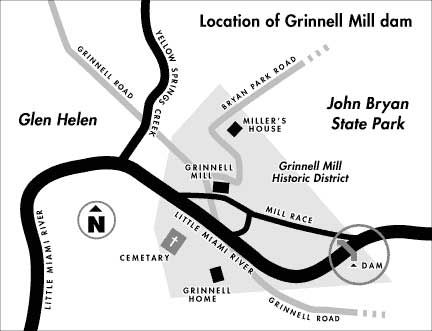                                                |
|
 |
|
|
State
river program considering removing Glen’s Grinnell Mill dam
The stone and concrete dam just upstream of the Grinnell Mill on the Little
Miami River may be shoring up the waters of its last spring season in
the South Glen.
The Scenic Rivers Program of the Ohio Department of Natural Resources
is considering removing the dam, which is part of the Grinnell Mill Historic
District. The program held a meeting last Thursday, March 20, in the Glen
Helen Building, in accordance with the National Historic Preservation
Act of 1966, to request public input on its proposal.
Though participants quipped momentarily about how to demolish the dam,
they reached a concensus that the dam should be removed.
According to the ODNR, in addition to its current state of disrepair,
the dam poses a safety hazard to hikers, canoeists and the Girl Scout
troops which own the property on the south side of the river adjacent
to the dam.
When the river is flowing, the slick dam poses a drowning threat, Girl
Scout camp leader Todd Catchpole said. And when the river is low, the
rocky river bed below the dam creates a treacherous hazard if someone
were to fall.
Removing the dam makes sense from an ecological perspective as well, several
participants said. According to the ODNR, restoring the Little Miami to
its naturally free flowing state would improve water quality, increase
biodiversity and return the river to its natural habitat. The agency has
worked to remove many of the Ohio Scenic River dams that destroy aquatic
life and compromise the river’s ecological integrity, ODNR representative
Kim Baker said.
Local resident Milt Lord, a member of the Ohio Scenic Rivers advisory
council, said he has been trying to have the Grinnell dam removed for
30 years. He said that dams harm rivers by creating stagnant pools of
water, which, in turn, breed only aquatic species that can tolerate pollution.
“If we can get them all out, so much the better for the scenic rivers,”
he said.
Historians see things a little differently. Removing the Grinnell dam,
which was originally built around 1812 to power Andrew and Robert Moody’s
gristmill in the early days of the village, would eliminate a cultural
relic that represents what this area once was, Ohio Historic Preservation
Office representative Justin Cook said.
According to the historic register nomination prepared by Antioch College
and the Ohio Historical Society, Grinnell Mill may be one of the oldest
existing mills in Ohio. The mill was first constructed about the same
time the dam was built, but the current building was reconstructed after
a fire around 1832 and then purchased by Frank Grinnell in 1862. It has
been a gristmill, a sawmill and a limestone processor for agricultural
lime in the early 1900s. The mill operated until 1937 and was acquired
by Antioch College as part of Glen Helen a decade later.
The entire district includes Grinnell Mill, its mill race, the dam, the
miller’s house, Grinnell House and the Grinnell family cemetery,
all contributing toward the memory of a milling heritage of 19th century
America. It has been on the National Register of Historic Places since
1982.
Don Hutslar, who grew up in Yellow Springs in the 1930s, said he remembers
the mill when it was still operating.
“Father took corn there to be cracked when all the millstones were
ground down and nobody wanted to sharpen them,” said Hutslar, whose
family raised hogs at that time and used the cracked corn to make slop
to feed them.
Though many villagers present at the meeting recognized the historical
value of the dam, none thought it was financially feasible to save it.
Local resident Dave Case, a member of Little Miami, Inc., said he has
spent considerable energy in the past trying to generate interest from
the Ohio Historical Society and local residents to preserve the mill area.
“There is no interest,” he said. “The mill is one of the
major historical features of this area and it’s a shame to see it
go . . . But the dam is nowhere close to being usable.”
The entire mill district is badly in need of restoration, he said.
Local resident Bill Hooper, a member of the Antioch University Board of
Trustees, said that the college does not have the resources to restore
the dam and that it should be removed for safety reasons.
If saving the dam is not an option, based on comments made at the meeting,
minimizing the effects of its extraction on the rest of the historic district
appears to be the next favorable option. Baker of ODNR said the department
was interested in hearing suggestions to mitigate the impact the project
could have on the district and the environment.
Preserving the two pieces of concrete on either side of the dam once it’s
removed was one option Lord presented. Case suggested using the stones
from the dam to fill in the mill race, being sure to document the dam
removal to preserve that part of the history of Glen Helen.
Antioch University, which owns the property north of the river adjacent
to the dam, gave ODNR permission to remove the dam in 2000, Glen Helen
Ecology Institute director Bob Whyte said.
The Girl Scouts also gave their approval. “Our need to keep people
from getting hurt outways the historical significance,” Catchpole
said.
Before taking action, ODNR will weigh all points of view to balance the
importance of the cultural, historical, aesthetic and recreational resources
of the area, Baker said. The ODNR will have to secure a permit from the
U.S. Army Corps of Engineers and get the Ohio Historical Society to approve
final plans. The ODNR would pay to remove the dam.
If things move smoothly, the removal could take place sometime in the
fall of this year, the Ohio Scenic River manager, Bob Grable said.
—Lauren
Heaton
|



